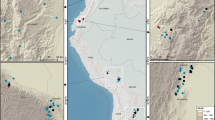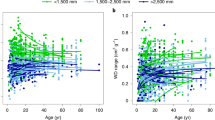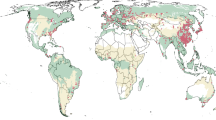Abstract
Quantifying carbon dynamics in forests is critical for understanding their role in long-term climate regulation1,2,3,4. Yet little is known about tree longevity in tropical forests3,5,6,7,8, a factor that is vital for estimating carbon persistence3,4. Here we calculate mean carbon age (the period that carbon is fixed in trees7) in different strata of African tropical forests using (1) growth-ring records with a unique timestamp accurately demarcating 66 years of growth in one site and (2) measurements of diameter increments from the African Tropical Rainforest Observation Network (23 sites). We find that in spite of their much smaller size, in understory trees mean carbon age (74 years) is greater than in sub-canopy (54 years) and canopy (57 years) trees and similar to carbon age in emergent trees (66 years). The remarkable carbon longevity in the understory results from slow and aperiodic growth as an adaptation to limited resource availability9,10,11. Our analysis also reveals that while the understory represents a small share (11%) of the carbon stock12,13, it contributes disproportionally to the forest carbon sink (20%). We conclude that accounting for the diversity of carbon age and carbon sequestration among different forest strata is critical for effective conservation management14,15,16 and for accurate modelling of carbon cycling4.
This is a preview of subscription content, access via your institution
Access options
Access Nature and 54 other Nature Portfolio journals
Get Nature+, our best-value online-access subscription
$29.99 / 30 days
cancel any time
Subscribe to this journal
Receive 12 digital issues and online access to articles
$119.00 per year
only $9.92 per issue
Buy this article
- Purchase on Springer Link
- Instant access to full article PDF
Prices may be subject to local taxes which are calculated during checkout



Similar content being viewed by others
Data availability
The input data and R-scripts to generate the figures and tables are available for download using the following private link: https://figshare.com/s/06c793575d3b52ef5574. Images of wood cores are available using the following link: https://figshare.com/s/e6101fe7d330f8ea140a. This folder also contains all annotation documents needed to visualize growth ring boundaries on the wood samples (please consult the README document for guidelines). Wood samples used to conduct this analysis are stored in the Tervuren xylarium (http://www.africamuseum.be/collections/browsecollections/naturalsciences/earth/xylarium). These samples may be studied, within the Tervuren xylarium, on request addressed to the curator H.B. (hans.beeckman@africamuseum.be) or the corresponding author W.H. (whubau@gmail.com).
References
Lewis, S. L. et al. Increasing carbon storage in intact African tropical forests. Nature 457, 1003–1006 (2009).
Brienen, R. J. W. et al. Long-term decline of the Amazon carbon sink. Nature 519, 344–348 (2015).
Körner, C. A matter of tree longevity. Science 355, 130–131 (2017).
Galbraith, D. et al. Residence times of woody biomass in tropical forests. Plant Ecol. Divers. 6, 139–157 (2013).
Brienen, R. J. W., Schöngart, J. & Zuidema, P. A. in Tropical Tree Physiology Vol. 6 (eds. Goldstein, G. & Santiago, L. S.) 439–461 (Springer, New York, 2016).
Worbes, M. One hundred years of tree-ring research in the tropics – a brief history and an outlook to future challenges. Dendrochronologia 20, 217–231 (2002).
Vieira, S. et al. Slow growth rates of Amazonian trees: consequences for carbon cycling. Proc. Natl Acad. Sci. USA 102, 18502–18507 (2005).
Chambers, J. Q., Higuchi, N. & Schimel, J. P. Ancient trees in amazonia. Nature 391, 135–136 (1998).
Bigler, C. Trade-offs between growth rate, tree size and lifespan of mountain pine (Pinus montana) in the Swiss national park. PLoS ONE 11, 1–18 (2016).
Kleczewski, N. M., Herms, D. A. & Bonello, P. Effects of soil type, fertilization and drought on carbon allocation to root growth and partitioning between secondary metabolism and ectomycorrhizae of Betula papyrifera. Tree Physiol. 30, 807–817 (2010).
Sass-Klaassen, U. Tree physiology: tracking tree carbon gain. Nat. Plants 1, 15175 (2015).
Bastin, J.-F. et al. Seeing Central African forests through their largest trees. Sci. Rep. 5, 1–8 (2015).
Bastin, J. -F. et al. Pan-tropical prediction of forest structure from the largest trees. Glob. Ecol. Biogeogr. 27, 1366–1383 (2018).
Lutz, J. A. et al. Global importance of large-diameter trees. Glob. Ecol. Biogeogr. 27, 849–864 (2018).
Memiaghe, H. R., Lutz, J. A., Korte, L., Alonso, A. & Kenfack, D. Ecological importance of small-diameter trees to the structure, diversity and biomass of a tropical evergreen forest at Rabi, Gabon. PLoS ONE 11, 1–15 (2016).
Burton, J. I., Ares, A., Olson, D. H. & Puettmann, K. J. Management trade-off between aboveground carbon storage and understory plant species richness in temperate forests. Ecol. Appl. 23, 1297–1310 (2013).
Lloyd, J. & Farquhar, G. D. The CO2 dependence of photosynthesis, plant growth responses to elevated atmospheric CO2 concentrations and their interaction with soil nutrient status. I. General principles and foreste cosystems. Funct. Ecol. 10, 4–32 (1996).
Laurance, W. F. et al. Inferred longevity of Amazonian rainforest trees based on a long-term demographic study. Forest Ecol. Manag. 190, 131–143 (2004).
Stephenson, N. L. et al. Rate of tree carbon accumulation increases continuously with tree size. Nature 507, 90–93 (2014).
Wright, S. J. et al. Functional traits and the growth — mortality trade-off in tropical trees. Ecology 91, 3664–3674 (2013).
Synnott, T. J. A Manual of Permanent Plot Procedures for Tropical Rain Forests Tropical Forestry Papers No. 14 (Department of Forestry Commonwealth Forestry Institute, Oxford Univ., 1979).
Dawkins, H. C. & Field, D. R. B. A Long-term Surveillance System for British Woodland Vegetation C.F.I. Occasional Papers 1 (Oxford Univ., 1978).
Lewis, S. L. et al. Above-ground biomass and structure of 260 African tropical forests. Philos. Trans. R. Soc. B 368, 20120295 (2013).
Hall, J. S., Harris, D. J., Medjibe, V. P. & Ashton, M. S. The effects of selective logging on forest structure and tree species composition in a Central African forest: implications for management of conservation areas. Forest Ecol. Manage. 183, 249–264 (2003).
Couralet, C., Van den Bulcke, J., Ngoma, L. M., Van Acker, J. & Beeckman, H. Phenology in functional groups of Central African trees. J. Trop. For. Sci. 25, 361–374 (2013).
Vico, G., Dralle, D., Feng, X., Thompson, S. & Manzoni, S. How competitive is drought deciduousness in tropical forests? A combined eco-hydrological and eco-evolutionary approach. Environ. Res. Lett. 12, 65006 (2017).
Bennett, A. C., McDowell, N. G., Allen, C. D. & Anderson-Teixeira, K. J. Larger trees suffer most during drought in forests worldwide. Nat. Plants 1, 15139 (2015).
The Charcoal Transition : Greening the Charcoal Value Chain to Mitigate Climate Change And Improve Local Livelihoods (FAO, 2017).
Lewis, S. L., Malhi, Y. & Phillips, O. L. Fingerprinting the impacts of global change on tropical forests. Philos.T. Roy. Soc. B 359, 437–462 (2004).
Rapport Annuel INEAC-Luki (INEAC, 1947).
Coppieters, G. Inventaris van het archief van de Rijksplantages en de Regie der Plantages van de Kolonie, het Nationaal Instituut voor de Landbouwkunde in Belgisch-Congo en de Documentatiedienst voor Tropische Landbouwkunde en Plattelandsontwikkeling 1901–1999 (REPCO, 2013).
Biographie Coloniale Belge/Biographie Belge d’Outre-Mer IX (Académie Royale des Sciences d’outre-mer, 2015).
Rapport Annuel INEAC-Luki (INEAC,1946).
Rapport Annuel INEAC-Luki (INEAC,1948).
De Mil, T., Vannoppen, A., Beeckman, H., Van Acker, J. & Van Den Bulcke, J. A field-to-desktop toolchain for X-ray CT densitometry enables tree ring analysis. Ann. Bot. 117, 1187–1196 (2016).
Gärtner, H. & Nievergelt, D. The core-microtome: a new tool for surface preparation on cores and time series analysis of varying cell parameters. Dendrochronologia 28, 85–92 (2010).
Dierick, M. et al. Recent micro-CT scanner developments at UGCT. Nucl. Instrum. Meth. A 324, 35–40 (2014).
Vlassenbroeck, J. et al. Software tools for quantification of X-ray microtomography at the UGCT. Nucl. Instrum. Meth. A 580, 442–445 (2007).
Worbes, M. in Encyclopedia of Forest Sciences Vol. 2 (eds. Burley, J., Evans, J. & Youngquist, J. A.) 586–599 (Academic Press, Cambridge, 2004).
Tarelkin, Y. et al. Growth-ring distinctness and boundary anatomy variability in tropical trees. IAWA J. 37, 275–294 (2016).
Hietz, P. A simple program to measure and analyse tree rings using Excel, R and SigmaScan. Dendrochronologia 29, 245–250 (2011).
Lopez-Gonzalez, G., Lewis, S. L., Burkitt, M. & Phillips, O. L. ForestPlots.net: a web application and research tool to manage and analyse tropical forest plot data. J. Veg. Sci. 22, 610–613 (2011).
R: A Language and Environment for Statistical Computing (R Core Team, 2008).
Chave, J. et al. Improved allometric models to estimate the aboveground biomass of tropical trees. Glob. Change Biol. 20, 3177–3190 (2014).
Feldpausch, T. R. et al. Tree height integrated into pantropical forest biomass estimates. Biogeosciences 9, 3381–3403 (2012).
Lopez-Gonzalez, G., Sullivan, M. J. P. & Baker, T. R. BiomasaFP package. Tools for analysing data downloaded from ForestPlots.net. R package version 0.2.1 (ForestPlots/BiomasaFDP, 2015); http://www.forestplots.net/en/resources/analysis.
Aalde, H. et al. Forest Land. IPCC Guidelines for National Greenhouse Gas Inventories Vol. 4: Agriculture, Forestry and Other Land Use, Ch 4, 1–29 (IPCC, 2006).
Talbot, J. et al. Methods to estimate aboveground wood productivity from long-term forest inventory plots. Forest Ecol. Manage. 320, 30–38 (2014).
Clark, D. A. et al. Measuring net primary production in forest concepts and field methods. Ecol. Appl. 11, 356–370 (2001).
Benjamini, Y. & Hochberg, Y. Controlling the false discovery rate: a practical and powerful approach to multiple testing. J. R. Stat. Soc. Ser. B 57, 289–300 (1995).
Acknowledgements
Nkulapark: W.H. and T.D.M. were both funded by the Brain programme of the Belgian Federal Government (BR/132/A1/AFRIFORD and BR/143/A3/HERBAXYLAREDD). The PhD project of T.D.M and the tenure track of J.V.d.B. were supported by Ghent University Special Research Fund (BOF). Fieldwork was sponsored by the King Leopold III fund for nature exploration and conservation. B.A.I. is supported by the Institut National pour l’Étude et la Recherche Agronomiques en R.D.Congo (INERA- RDC- Luki) and the École Régionale Postuniversitaire d’Aménagement et de Gestion intégrés des Forêts et Territoires tropicaux (ERAIFT Kinshasa). We thank WWF-RDC (G. Lejeune), INERA and ERAIFT for facilitating fieldwork in the Luki Reserve. We thank the INERA employees (J.-B. Ndunga, J.-M., F. Mbungu Phaka, L. Ngoma, P. Noble), the WWF ecoguards and the students of the Universities of Kinshasa (UNIKIN) and Boma for assistance in the field. For assistance with datasets we thank M. De Groot, K. Lievens, P. Dekeyser, S. Willen and J. Kempenaers. The 23 permanent inventory plots: This paper is also a product of the AfriTRON network, for which we are indebted to hundreds of institutions, field assistants and local communities for establishing and maintaining the plots. This network has been supported by the European Research Council (291585, ‘T-FORCES’ – Tropical Forests in the Changing Earth System, Advanced Grant to O.L.P. and S.L.L.), the Gordon and Betty Moore Foundation, the David and Lucile Packard Foundation, the European Union’s Seventh Framework Programme (no. 283080, ‘GEOCARBON’) and Natural Environment Research Council (NERC) Consortium Grant ‘TROBIT’ (no. NE/D005590/1), ‘BIO-RED’ (no. NE/N012542/1) and a NERC New Investigators Grant, the Royal Society, the Centre for International Forestry (CIFOR) and Gabon’s National Parks Agency (ANPN). We are indebted to the University of Yaounde I, the National Herbarium of Yaounde, Rougier-Gabon, the Marien Ngouabi University of Brazzaville, WCS-Congo, Salonga National Park, WCS-D.R.Congo and the University of Kisangani for logistical support in Africa.
Author information
Authors and Affiliations
Contributions
W.H., T.D.M., J.V.d.B., J.V.A. and H.B. conceived and designed the Nkulapark study and S.L.L. conceived the AfriTRON plot network. T.D.M. and B.A.I. coordinated collection of Nkulapark data and wood cores. T.D.M. and J.V.d.B. measured growth ring series. W.H. carried out the data analysis and wrote the paper. S.L.L., O.L.P., T.R.B. and Y.M. conceived the ForestPlots.net database, and most co-authors helped collecting AfriTRON forest census data. S.L.L., B.S., S.K.B., A.C.S., W.H., T.S., T.R.F., T.S., C.E.N.E. and L.W.W. coordinated forest plots data collection. M.J.P.S., G.L.G., S.L.L., O.L.P., T.R.B. and G.P. contributed tools to analyse and curate data. All co-authors commented on or approved the manuscript.
Corresponding author
Ethics declarations
Competing interests
The authors declare no competing interests.
Additional information
Publisher’s note: Springer Nature remains neutral with regard to jurisdictional claims in published maps and institutional affiliations.
Supplementary information
Supplementary Information
Supplementary Figures 1–4
Supplementary Table 1
Number of growth rings, growth-ring formation rate, tree age and mean carbon age of all 55 Nkulapark trees with 1,948 nail traces used for this analysis
Supplementary Table 2
List of all 23 plots included in this analysis, with geographic coordinates, plot size, dates of first and last census, and the main researchers for each plot
Rights and permissions
About this article
Cite this article
Hubau, W., De Mil, T., Van den Bulcke, J. et al. The persistence of carbon in the African forest understory. Nature Plants 5, 133–140 (2019). https://doi.org/10.1038/s41477-018-0316-5
Received:
Accepted:
Published:
Issue Date:
DOI: https://doi.org/10.1038/s41477-018-0316-5
This article is cited by
-
Co-limitation towards lower latitudes shapes global forest diversity gradients
Nature Ecology & Evolution (2022)
-
Implications of size-dependent tree mortality for tropical forest carbon dynamics
Nature Plants (2021)
-
The Forest Observation System, building a global reference dataset for remote sensing of forest biomass
Scientific Data (2019)



